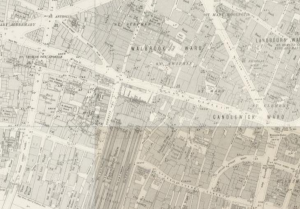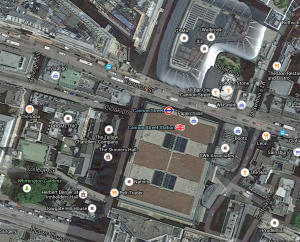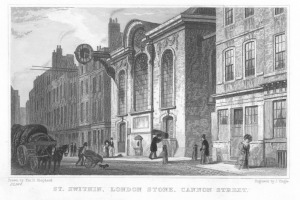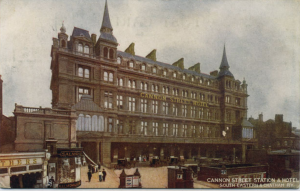In The Man with the Twisted Lip, by Sir Arthur Conan Doyle, Cannon Street is mentioned in the beginning of the story when Holmes is describing his new case to Watson. He describes Neville St. Clair to Watson and what his daily routine looks like. In the story, Holmes tells Watson, “He had no occupation, but was interested in several companies, and went into town as a rule in the morning, returning by the 5.14 from Cannon Street every night” (133). We all know how the story goes. After investigation, St. Clair is revealed to disguising himself as a beggar due to the simple fact that he made more money begging than any other job. St. Clair’s daily routine consisted of him returning home from Cannon Street. After doing some research about this street, this Sherlock Holmes story ties into the history of Cannon Street.
Cannon Street was a poor area of Victorian London. According to Charles Booth’s Poverty Map, Cannon Street is poor. This map also states that this area housed many 18-21 year olds. After researching Old Bailey Proceedings, I found that many crimes were related to burglary. In fact, there are 54 cases listed as theft. Cannon Street was also a road that lead to Cannon Street Station. An area that includes a major transportation station for a city could be very populated. This could also lead to increase in crime. The dominant young-aged civilians that lived on Cannon Street could also play a part in crime.
Cannon Street was originally called Candlewick Street. It was named this due to the candle makers who lived there. After them, it became home to drapers, who sell cloth and dry goods. The ancient Roman milestone, now the London Stone, also resides on Cannon Street in the church of St. Swithin. The legend of this stone says that it is so strong and rooted to the earth that even if a car were to hit into it, it would not move. The car would dent before the rock moved. During the Fire of London, the stone was half destroyed. There is now a new, less powerful, stone on top of the old stone to preserve the old stone. In 1866, the Railway Extension opened, creating a connection with Charing Cross and London Bridge. There is a signal box at the entrance of Cannon Street that extends across the entire bridge. There is also a hotel on Cannon Street which has visually appealing architecture.
Bibliography
- Locating London’s Past, The Old Bailey Proceedings, 1700-1814, Theft, Cannon Street.
- http://www2.warwick.ac.uk/fac/arts/english/currentstudents/undergraduate/modules/fulllist/special/endsandbeginnings/twistedlip.pdf
- Walter Thornbury, ‘Cannon Street’, in Old and New London: Volume 1 (London, 1878), pp. 544-550 http://www.british-history.ac.uk/old-new-london/vol1/pp544-550 [accessed 8 November 2015].
- http://booth.lse.ac.uk/cgi-bin/do.pl?sub=view_booth_and_barth&args=532366,180940,1,large,0





